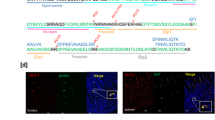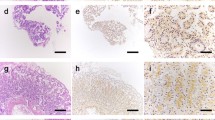Abstract.
Gastrin-producing G cells constitute one of the major populations of neuroendocrine cells in the antral mucosa of the stomach. The peroxisome proliferator-activated receptor (PPAR) α-agonist ciprofibrate is used as a lipid-lowering drug. Recently, ciprofibrate has been shown to induce hypergastrinemia in rats without reducing gastric acidity, which indicates a direct stimulatory effect on the G cell. Gastrin probably plays an important role in gastric tumorgenesis, and long-term dosing with ciprofibrate results in enterochromaffin-like (ECL) cell carcinoids in the oxyntic mucosa of rats. In this study, we aimed to examine changes of neuroendocrine granules in G cells following ciprofibrate dosing and relate them to changes induced by the proton pump inhibitor pantoprazole. Furthermore, we wanted to study peroxisomes in G cells. Rats received ciprofibrate 80 mg/kg/day or pantoprazole 200 mg/kg/day in 4 weeks. Antral mucosal specimens were processed for conventional staining procedures and immunocytochemistry for both the light and electron micro-scope. Specimens were immunolabeled for gastrin and peroxisome-specific proteins. Electron micrographs were analyzed planimetrically. This study shows that hypergastrinemia induced by ciprofibrate is accompanied by a decrease in granule number per cell and a relative increase in electron-dense granules. These changes were quite similar to those induced by pantoprazole, indicating signs of G-cell activation in general. However, distinctions concerning granule size and composition and both hypertrophy and hyperplasia of G cells are presented. Finally, demonstration of peroxisomes in G cells was only achieved by using the highly sensitive tyramide signal amplification technique in immunostaining for the peroxisome-specific protein PMP-70. Therefore, neither morphological nor quantitative changes of peroxisomes in G cells were detected.
Similar content being viewed by others
Author information
Authors and Affiliations
Additional information
Received: June 3, 2002 / Accepted: August 16, 2002
Acknowledgment We are grateful to PhD Ingunn Bakke of the Department of Intra-abdominal Diseases, NTNU Trondheim, Norway, for theoretical and technical assistance in the immunocytochemical procedures.
Correspondence to T. C. Martinsen
Rights and permissions
About this article
Cite this article
Martinsen, T., Skogaker, N., Bendheim, M. et al. Antral G cells in rats during dosing with a PPARα agonist: a morphometric and immunocytochemical study. Med Electron Microsc 36, 18–32 (2003). https://doi.org/10.1007/s007950300003
Issue Date:
DOI: https://doi.org/10.1007/s007950300003




